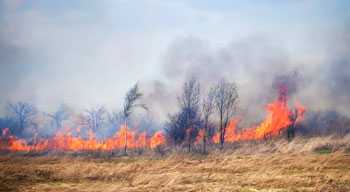Public Safety Program
Wildland Fire

Every year, hundreds of thousands of acres of land burn across the United States and Wildland Firefighters (WFFs) are asked to protect our lives, our homes and our forests. NIOSH provides up-to-date information about occupational health and safety research and investigations conducted by NIOSH and our partners.
NIOSH Resources and Publications
NIOSH Science Blog: Arduous Duty: Using Three Data Sources to Create a Single Wildland Fire Fighter On-Duty Death Surveillance System
Wildland fire fighter-specific fatality data is often sparse or combined with information on all U.S. fire fighter deaths. To help answer our partners’ most basic on-duty fatality questions, the NIOSH Wildland Fire Program created a surveillance system to track wildland fire fighter fatalities in the U.S.
Wildland Fire Fighting Safety and Health
This NIOSH Science Blog lists the multiple hazards Wildland Firefighters face in the line of duty and provides suggestions on how to avoid these conditions, injuries, and illnesses.
Wildland Fire Fighting: Hot Tips to Stay Safe and Healthy
Wildland Firefighters risk their lives every day to protect the people and land affected by these unpredictable and dangerous fires. Reviewing these recommended practices for safety tips and common health hazards.
Fire Fighter Fatality Investigation and Prevention Program
NIOSH conducts investigations of fire fighter line-of-duty deaths to formulate recommendations for preventing future deaths and injuries. The program does not seek to determine fault or place blame on fire departments or individual fire fighters, but to learn from these tragic events and prevent future similar events. Search for reports of interest.
Some recent examples are:
- Wildland Fire Fighter Trainee Suffers Sudden Cardiac Death during Physical Fitness Exercise - California
- Volunteer Fire Fighter Dies and 5 Volunteer Fire Fighters are Injured during Wildland Urban Interface Fire —Texas
- Wildland Fire Fighter Dies from Hyperthermia and Exertional Heatstroke While Conducting Mop-Up Operations – Texas
- Fire Crew Supervisor Suffers Sudden Cardiac Death During Pack Test – Wyoming
Preventing Firefighter Fatalities from Cardiovascular Events
NIOSH recommends that fire departments and firefighters follow established medical screening guidelines, adopt risk reduction measures during firefighting operations, and develop and participate in comprehensive wellness and fitness programs
Heat Stress
Workers who are involved in extreme heat environments are susceptible to different occupational hazards, illnesses, and injuries. See the NIOSH topic page for blogs, featured publications, infographics, and other documents on preventative measures to stay safe in hot environments.
Fire Fighter Deaths from Tanker Truck Rollovers
Mobile water supply vehicles, known as tankers or tenders, are widely used to transport water to areas beyond a water supply system or where the water supply is inadequate. Incidents involving motor vehicles account for approximately 20% of U.S. fire fighter deaths each year; cases involving tankers are the most prevalent of these motor vehicle incidents
Preventing Death and Injuries of Fire Fighters Operating Modified Excess/Surplus Vehicles
Work Schedules: Shift work and Long Work Hours
Both shift work and long work hours have been associated with health and safety risks. This page provides links to NIOSH publications and other resources that address demanding work schedules.
Non-NIOSH Publications
Rhabdomyolysis: What Wildland Fire Fighters Need To Know
Recommendations for Wildland Smoke
Hazards that may be present in areas affected by wildfires
Organizations
National Wildfire Coordinating Group (NWCG)
- Page last reviewed: January 4, 2017
- Page last updated: February 17, 2017
- Content source:
- National Institute for Occupational Safety and Health Office of the Director


 ShareCompartir
ShareCompartir